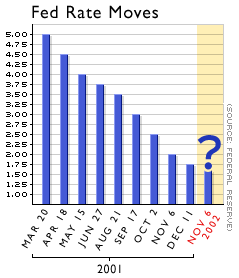NEW YORK (CNN/Money) -
There isn't much debate on Wall Street over whether Federal Reserve policy makers will cut rates when they gather Wednesday -- almost everyone assumes they they will. But the question of whether the Fed will cut the funds target rate by a quarter-percentage point or a more aggressive half point has caused some division.
Economic data have shown the economy continued to weaken last month, virtually ensuring that the Fed will cut. Last Friday, the monthly jobs report showed that the U.S. lost another 5000 jobs in October while the unemployment rate crept up to 5.7 percent from September's 5.6 percent. The Institute of Supply Management's Purchasing Managers' Index fell one point to 48.5, indicating that the manufacturing economy continued to contract. Monday, Challenger Gray & Christmas reported that job-cut announcements jumped to their highest level since January last month.
Market expectations are for the Fed to cut by just a quarter-percentage point Wednesday. Fed-funds futures -- monthly futures contracts that indicate how traders are betting the Fed will act -- have priced in a quarter-point cut, but show only a slight chance of a half-point rate drop. Some economists disagree with that assessment.
"Why screw around? If they're going to cut, they'll go a half-point," said Diane Swonk, chief economist at Bank One. "They're just not in a position to be taking risks."
Swonk feels the economy has the wherewithal to muddle its way through to recovery, but believes that the danger posed by a double-dip recession still needs to be taken seriously. Moreover, with the threat of inflation off the radar screen, there's not the same kind of risk of easing by too much as there was in the past.
Easy Al is your pal
The old saw says that Fed policy works with a lag, and it's true that a rate cut of either magnitude -- a half point or a quarter point -- wouldn't feed through to the economy through its traditional channels for some time. But it could help shore up confidence among businesses and prevent them from pulling back too sharply during the economy's latest rough patch. A cut would also keep short-term borrowing and mortgage costs low, and it could also give stocks a bump.

"It's not a panacea," said Goldman Sachs director of U.S. economic research Bill Dudley. "But it helps support the equity market; it helps corporate lending; it helps sustain consumer lending."
At September's meeting, where rates were left on hold, Fed Governor Edward Gramlich and Dallas Fed President Robert McTeer argued for a cut. Weak economic data since then suggest they were correct in their stance. At Wednesday's meeting, suspects Deutsche Bank's chief U.S. economist Cary Leahey, there will be a good deal of debate between doves like Gramlich and McTeer, who will want to cut by a half point, and hawks like Cleveland Fed President Jerry Jordan, who will want to cut by a quarter point.
This time around, Fed Chairman Greenspan is likely to side with the doves. First, this way he'll have fewer dissenting voices. Second, the Fed will look out of step if it ignores the doves again, and then ended up cutting rates by another quarter-percentage point at some later meeting.
"I lean toward a half point instead of a quarter," said Leahey. "The Fed wants to shore up confidence, to show that, unlike the European Central Bank, it feels your pain."
The European Central Bank has been slow to cut rates, despite mounting unemployment and a sluggish European economy.
Still, there are often differences between what some people think the Fed should do and what the Fed actually does. There are reasons the market is betting on a quarter-point cut instead of a half-point one.
"The best tack is to move by a quarter point, with the promise that there will be more cuts to come if the economy remains weak," said Lehman Brothers economist Ethan Harris. "You can't maintain that promise with big bulky rate cuts."
Moreover, thinks Miller Tabak bond market strategist Tony Crescenzi, the economy simply hasn't shown the sort of weakness yet that would prompt the Fed to move aggressively.
"The Fed's theme has been that this is only a bump along the road to recovery, and they can't smooth every bump," he said.
Crescenzi thinks that one of the big reasons for cutting by a half point -- to help give support to the equity market -- just doesn't make sense. The Fed's 11 cuts last year didn't do much for stocks.
"Why do something that has only a short-term effect on the market?," he said. "It's wasteful."
For that matter, why cut at all? If dropping the funds rate from 6.5 percent to 1.75 percent didn't do anything, what's another half point?
"Because it's better than doing nothing," said Dudley. "A wild boar charges you and you shoot four of the six shots in your gun at it and it doesn't fall. Do you look at your gun philosophically and think, the first four shots didn't work, why bother?"

|

